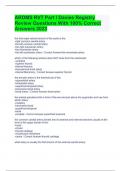Study guides, Class notes & Summaries
Looking for the best study guides, study notes and summaries about ? On this page you'll find 35 study documents about .
Page 2 out of 35 results
Sort by
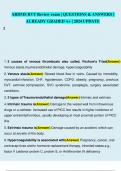
-
ARDMS RVT Review exam | QUESTIONS & ANSWERS | ALREADY GRADED A+ | 2024 UPDATE
- Exam (elaborations) • 14 pages • 2023
-
- $13.49
- + learn more
ARDMS RVT Review exam | QUESTIONS & ANSWERS | ALREADY GRADED A+ | 2024 UPDATE 1 1. 3 causes of venous thrombosis also called, Virchow's Triad(Answer) Venous stasis,trauma/endothelial damage, hypercoagulability 2. Venous stasis(Answer) Slowed blood flow in veins. Caused by immobility, myocardial infarction, CHF, hypotension, COPD, obesity, pregnancy, previous DVT, extrinsic compression, SVC syndrome, paraplegia, surgery associated conditions. 3. 2 types of Trauma/endothelial damage(Answ...
ARDMS RVT Part I Davies Registry Review Questions With 100% Correct Answers 2023
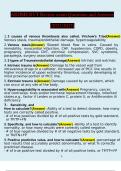
-
ARDMS RVT Review exam Questions and Answers (2022/2023)
- Exam (elaborations) • 14 pages • 2023
-
- $7.99
- + learn more
1. 3 causes of venous thrombosis also called, Virchow's Triad(Answer) Venous stasis, trauma/endothelial damage, hypercoagulability 2. Venous stasis(Answer) Slowed blood flow in veins. Caused by immobility, myocardial infarction, CHF, hypotension, COPD, obesity, pregnancy, previous DVT, extrinsic compression, SVC syndrome, paraplegia, surgery associated conditions. 3. 2 types of Trauma/endothelial damage(Answer) Intrinsic and extrinsic 4. Intrinsic trauma is(Answer) Damage to the vessel wall ...
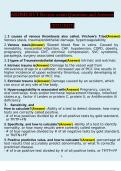
-
ARDMS RVT
- Exam (elaborations) • 14 pages • 2023
- Available in package deal
-
- $10.99
- + learn more
1.3 causes of venous thrombosis also called, Virchow's Triad(Answer) Venous stasis, trauma/endothelial damage, hypercoagulability 2.Venous stasis(Answer) Slowed blood flow in veins. Caused by immobility, myocardial infarction, CHF, hypotension, COPD, obesity, pregnancy, previous DVT, extrinsic compression, SVC syndrome, paraplegia, surgery associated conditions. 3.2 types of Trauma/endothelial damage(Answer) Intrinsic and extrinsic 4.Intrinsic trauma is(Answer) Damage to the vessel wall from...
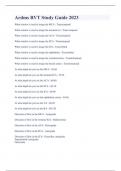
-
Ardms RVT Study Guide 2023
- Exam (elaborations) • 2 pages • 2023
- Available in package deal
-
- $3.69
- + learn more
Ardms RVT Study Guide 2023 What window is used to image the MCA - Transtemporal What window is used to image the terminal ica - Trans temporal What window is used to image the ACA - Transtemporal What window is used to image the PCA - Transtemporal What window is used to image the ICA - Transorbital What window is used to image the ophthalmic - Transorbital What window is used to image the vertebral artery - Transforamenal What window is used to image the basilar artery -...
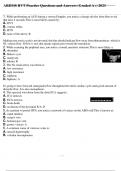
-
ARDMS RVT Practice Questions and Answers (Graded A+) 2023
- Exam (elaborations) • 17 pages • 2023
- Available in package deal
-
- $13.99
- + learn more
ARDMS RVT Practice Questions and Answers (Graded A+) 2023 1. While performing an AUG during a venous Doppler, you notice a change of color from blue to red that lasts 4 seconds. This is most likely caused by: A. DVT B. venous reflux C. HTN D. none of the above: B Making sure you're scale is not inverted, the blue should indicate flow away from the transducer, which is NL venous flow. If flow is red, that means signal goes toward the transducer. 2. While scanning the popliteal area, ...
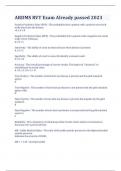
-
ARDMS RVT Exam Already passed 2023
- Exam (elaborations) • 3 pages • 2023
- Available in package deal
-
- $7.99
- + learn more
ARDMS RVT Exam Already passed 2023 Positive Predictive Value (PPV) - The probability that a patient with a positive test result really does have the disease. =A / A + B Negative Predictive Value (NPV) - The probability that a patient with a negative test result really is free if disease. D / D + C Sensitivity - The ability of a test to detect disease when disease is present. A / A + C Specificity - The ability of a test to correctly identify a normal result. D / D + B Accurac...
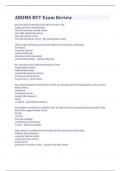
-
ARDMS RVT Exam Review Latest Update 2023
- Exam (elaborations) • 12 pages • 2023
- Available in package deal
-
- $11.49
- + learn more
ARDMS RVT Exam Review the first major arterial branch of the aorta is the: -right common carotid artery -the left common carotid artery -the right subclavian artery -the innominate artery -the left subclavian artery - the innominate artery which of the following arteries does NOT arise from the subclavian: -vertebral -superior thyroid -internal thoracic -thyrocervical trunk (axis) -internal Mammary - superior thyroid the annular artery is the terminal pat of the: -supraorbita...
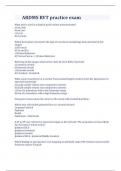
-
ARDMS RVT practice exam questions and Answers with Complete Solution 2023
- Exam (elaborations) • 4 pages • 2023
- Available in package deal
-
- $7.99
- + learn more
ARDMS RVT practice exam What unit is used in a dialysis graft volume measurements? a) mL/min b) mL/sec c) L/sec d) cm/min - Which description represents the type of waveform morphology demonstrated in this image? a) Pre-steal b) To and Fro c) Pulsus Bisferiens d) Tarvus-Parvus - c) Pulsus Bisferiens Referring to this image, which artery does #2 most likely represent a) common carotid b) Internal carotid c) External carotid d) Vertebral - Vertebral What causes waveforms...
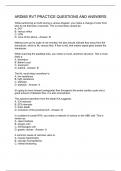
-
ARDMS RVT PRACTICE QUESTIONS AND ANSWERS
- Exam (elaborations) • 16 pages • 2023
-
- $12.49
- + learn more
While performing an AUG during a venous Doppler, you notice a change of color from blue to red that lasts 4 seconds. This is most likely caused by: A. DVT B. venous reflux C. HTN D. none of the above - Answer- B Making sure you're scale is not inverted, the blue should indicate flow away from the transducer, which is NL venous flow. If flow is red, that means signal goes toward the transducer. While scanning the popliteal area, you notice a round, anechoic structure. This is most lik...

Study stress? For sellers on Stuvia, these are actually golden times. KA-CHING! Earn from your study resources too and start uploading now. Discover all about earning on Stuvia

